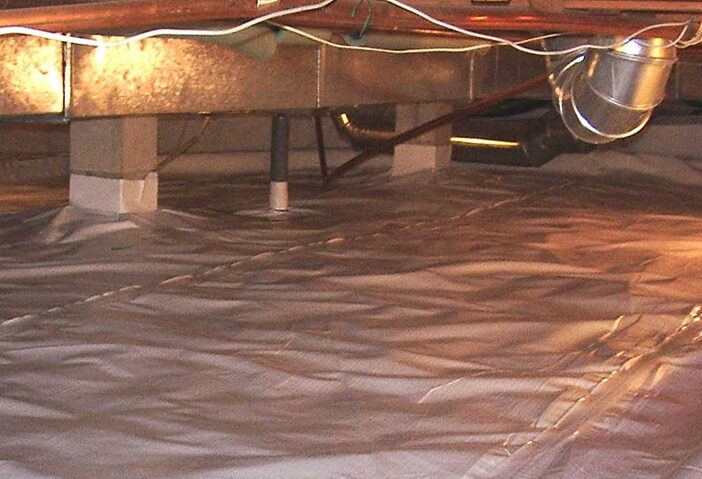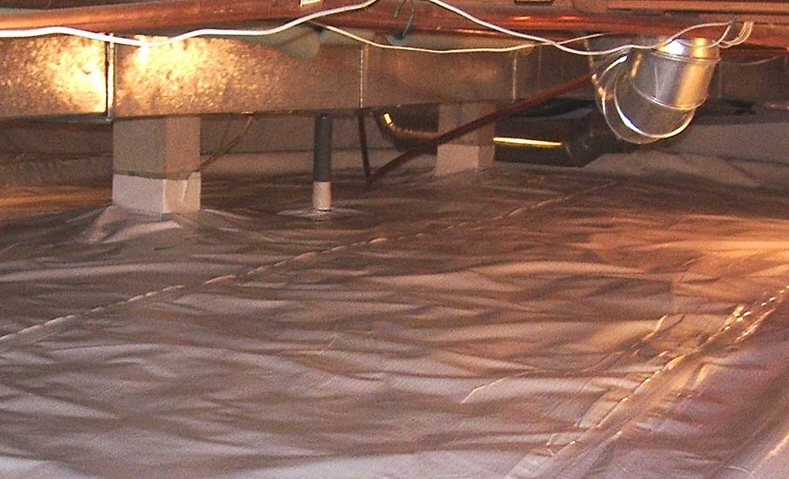
There are many benefits to encapsulating your crawl space—eliminating moisture damage, preventing deterioration and increasing energy efficiency, to name a few. Whether you are embarking on a DIY crawl space encapsulation project or installing a vapor barrier for a client, the first step is to determine how much vapor barrier material you’ll need to purchase.
Crawl spaces vary in size, but the minimum recommended height between the ground and the floor joists is 18 inches, with a maximum of approximately four feet. And while that may not sound nearly large enough for a full-grown human to enter—let alone move around in—they don’t call it a “crawl space” for nothing.
In truth, there isn’t a one-size-fits-all vapor barrier, but we are here to help you determine just how much material you’ll need to get the job done.
Measure Twice, Cut Once
Before making a purchase, you must first determine what size vapor barrier you’ll need to encapsulate your space—and unless you’ve got the blueprint to your house handy, you’ll need to do some measuring. Fortunately, measuring for a crawl space vapor barrier is fairly straightforward. Grab a tape measure, head into your crawl space (watch your head!) and measure the length, width and height of the walls. For odd-shaped foundations, you’ll want to measure by sections or rooms. Be sure to measure around any columns or piers, as they will need to be covered as well for optimum energy efficiency. TIP: For most crawl space projects, the rule of thumb is one roll of tape per 1,000 square feet of vapor barrier.
Calculating How Much Vapor Barrier You Need
Once you have the measurements of your crawl space, it’s time to calculate how much material you’ll need to cover the walls and floor. (Note: walls and floors should be calculated separately.)
The amount of material you need for the wall—also known as the perimeter—is calculated using the width, length and height of the crawl space:
- Add the length and width of the space.
- Multiply that number by two.
- Then, multiply the results by the height. This will give you the square footage needed for the wall.
Since most walls are less than four feet, we typically recommend a four- or six-foot wide roll, which should give you more than enough length to overlap the wall vapor barrier with the floor panels.
Measuring the floor is also quite simple—
Just multiply the width by the length to get the total square footage needed for the ground. The wider the width of the material, the fewer seams you will require when overlapping panels; often a 12’ wide roll works best for floors.
*Important note: You should account for an additional six inches or 10% of overlap between panels.
We have a crawl space vapor barrier calculator to help you with calculating how much material you need. Use our crawl space vapor barrier calculator here.
For more help, check out this video demonstration of how to measure your crawl space.
The Importance Of High-Quality Tape
High-quality tape can make all the difference when it comes to whether or not you crawl space vapor barrier will do the job. Here are a few important features to look for when choosing tape for your next project:
Adhesion
Adhesion is so much more than whether or not the tape is sticky – it needs to be able to adhere securely to surfaces like crawl space walls while still maintaining its bond over time. No one wants to deal with tape that starts to peel away after installation, after all. The tape you choose should perform well under conditions such as temperature variations and moisture. One of the main challenges with vapor barrier installations is making sure the tape will be able to survive through long-term exposure to environmental factors like pools of water that are allowed to collect near the seams. Low-quality tape may initially adhere well but can start to lose its effectiveness when subjected to water for extended periods of time. This can lead to peeling, which will compromise the vapor barrier’s seal. Always look for a tape that adheres consistently and reliably to the surfaces it’s designed for.
Flexibility Vs. Durability
Your tape’s flexibility is another important factor to consider. It needs to be bendable enough to seal effectively around corners and other irregular surfaces while still having enough rigidity to keep its strength. A high-quality tape will strike the right balance between durability and flexibility so that you can adhere different parts of your vapor barrier to your crawl space walls without having to worry about if you missed a spot or if your tape will hold for as long as the vapor barrier will.
Seal the Job With The Right Vapor Barrier Tape
As you can see, tape is an essential part of the vapor barrier installation process, as you’ll need it to overlap panels and seal the material to the wall. We generally recommend two types of tape for your crawl space application:
Vapor Tape
Vapor tape is designed as a cost-effective solution to reinforce and seal vapor barriers, but it shouldn’t be the only type of tape you use on your installation. It’s great for securing seams and edges, particularly on walls. And while vapor tape has strong adhesion and durability, it may not offer the same level of watertight sealing as butyl tape. But it’s quite easy to work with, making it a practical choice for less critical areas of your crawlspace or as a complement to butyl tape. The general rule of thumb with vapor tape is one roll for every 1,000 square feet of vapor barrier.
Butyl Tape
Butyl tape is an aggressive, self-healing, double-sided tape used to adhere the crawl space liner to the wall and seam the overlapping vapor barrier panels (where applicable). The amount of butyl tape you’ll need is based on the perimeter of the entire space, including any columns. It’s known for its great sealing capabilities and is really effective in creating airtight and watertight seals. This makes it ideal for crawl space walls where a strong, long-lasting bond is the priority. When used between overlapping panels on the ground, butyl tape offers additional protection by preventing water vapor from seeping through the seams. While it may add more upfront cost, its strong seal will reduce the risk of long-term moisture issues in your crawl space.
Christmas Tree Ratchet Fasteners
In addition to tape, you’ll need a fastener to keep the vapor barrier attached to the foundation wall. We recommend our Christmas Tree Ratchet Fasteners — they can be easily installed with a drill bit every 18-24 inches through the butyl tape, creating an airtight seal around the hole.
We’ve Got Crawl Spaces Covered
Americover is a leading source for high-quality, American-manufactured crawl space vapor barriers and liners. When installed properly, a top-quality vapor barrier can last you 20 years or more. Discover which size vapor barrier is right for your crawl space, and when you are ready to purchase, visit our online store to order yours and have it delivered right to your house or job site. Our friendly, knowledgeable staff is here to answer your questions and fulfill orders Monday-Friday from 6 a.m. to 6:30 p.m. Pacific Standard Time. If you would like to speak with one of our experts, call us at 760-388-6294.

